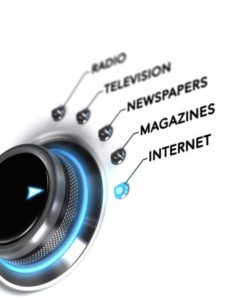Companies, of all shapes and sizes, are all trying to decipher the rapidly changing advertising channels and where best to invest their marketing dollars. Our last post compared digital marketing to newspaper marketing. How does digital or online marketing compare to the ROI of Radio ads? With so many radio sources: traditional AM/FM, online radio including internet radio, satellite radio and streaming services, there is much to analyze in this ever-changing media.
Radio Marketing Analysis
Advertising budgets continue to be reallocated from radio to other media channels, but online radio or streaming services are offering expanding services that entices advertisers including optimization capabilities and geo-targeting. The first consideration for advertisers or anyone assessing the industry will no doubt be audience size.
So here’s a breakdown of the various radio sources and their current audience size:
 Traditional AM/FM radio reaches 91% of the American public ages 12 and up (Pew Research Center analysis of Nielsen Media Research data, 2014). AM/FM’s revenue from “spot” advertising declined 3% in 2014.
Traditional AM/FM radio reaches 91% of the American public ages 12 and up (Pew Research Center analysis of Nielsen Media Research data, 2014). AM/FM’s revenue from “spot” advertising declined 3% in 2014.- Online radio listening reaches 53% of Americans (12 years and up) per month. This percentage doubled in just 5 years.
- Where are they listening? Online radio listening is increasingly being heard on smartphones, which includes 73% of their audience. Those listening on desktops/laptops are going down at 61%. And 35% of cell phone owners (35%) have listened to online radio in the car.
- Sirius XM – the only satellite radio platform in the U.S. – At the end of the last measured quarter, the company had 29.59 million subscribers, up from 20.5 million subscribers in 2010. Sirius XM saw an increase in revenue of 10%, up from $3.8 billion in 2013 to $4.2 billion in 2014.
- Streaming Music sources: Apple Music has 10 million subscribers, an impressive number for a service less than a year old. Spotify announced the 20 million mark in June 2015. Pandora is the leader with a reported 65.6 million active users, up from 47.6 million a year earlier. Nielsen reported in January 2015 that 67% of all music listeners access streaming services in a typical week.
Online Radio Usage is on the Rise …
 So the breakdown is while traditional AM/FM radio listening and ads revenues are decreasing each year, satellite and streaming music radio is increasing every year, taking more of the marketing as well as an increase on engagement and time spent listening per day. With online radio being more accessible, offering higher quality of sound, playable on multiple devices, and with the ability to select music preferences, its obvious why its become so popular in just a few years.
So the breakdown is while traditional AM/FM radio listening and ads revenues are decreasing each year, satellite and streaming music radio is increasing every year, taking more of the marketing as well as an increase on engagement and time spent listening per day. With online radio being more accessible, offering higher quality of sound, playable on multiple devices, and with the ability to select music preferences, its obvious why its become so popular in just a few years.
“The results indicated that 44% of listeners said Internet Radio was displacing time formerly dedicated to AM/FM broadcast radio stations.”- Xapp Media survey.
So as a result, Ad Revenue is affected by the various radio platforms:
In 2014, Pandora generated 732.34 million US dollars in advertising revenue. In addition to Pandora, Spotify is growing rapidly in the United States and has contributed more than $2 billion to artists while industry-wide streaming now accounts for 27% of revenue. Sirius XM saw an increase in revenue of 10%, up from $3.8 billion in 2013 to $4.2 billion in 2014, and $4.6 billion in 2015.
“AM/FM’s revenue from ‘spot’ advertising (ads aired during radio broadcasts, its main revenue source) declined 3% in 2014, while revenue from digital and off-air advertising both posted strong gains for the year – 9% and 16%, respectively.” – Journalism.org
What is the Average Cost of Traditional Radio Advertising?
There are three factors that affect pricing: Length of Airtime, Production Cost and Schedule.
Airtime is the unit of time that your commercial will run, usually in increments of 30-second, 60-second or 120-second segments (or spots), depending on the station. Second, production cost can be a factor, although many stations include it as an incentive, with some limitations to voice talent, sounds and effects. If you have specific wants for your ad that set your brand above the rest, then you may want to consider an outside firm to produce it.
“It may be worth a few thousand dollars to produce a top-notch spot that generates a response instead of an in-house spot package deal that does nothing.” – Entrepreneur.com
 Third is schedule, which is when and how often your ad plays. There are two types of scheduling: ROS (“run of station”) which is where the radio station determines your schedule, or Target Placed ads (or “flights”) when you determine the times/days. It might be worth your time and research to select your times with your radio sales rep. Why? Each radio station has various surveys so you can determine the best times of day and week that your target audience will be listening, so work closely with your rep to select the best times for your ad to run to get the best return on your investment.
Third is schedule, which is when and how often your ad plays. There are two types of scheduling: ROS (“run of station”) which is where the radio station determines your schedule, or Target Placed ads (or “flights”) when you determine the times/days. It might be worth your time and research to select your times with your radio sales rep. Why? Each radio station has various surveys so you can determine the best times of day and week that your target audience will be listening, so work closely with your rep to select the best times for your ad to run to get the best return on your investment.
Repetition is essential to get your ad heard and remembered especially in the radio market where listening can be sporadic and for brief spurts of time throughout the day (during a commute, at work, while multitasking other projects). Because radio advertising relies on repetition, you’ll need to pay for the continuous airplay to see any worthwhile results.
“You can expect to spend approximately $2,000 per week in a regional market and at least $3,000 with a larger metro station. Spending any less on your campaign is a waste of money; you simply won’t be able to get the repetition required to generate a result.” – Entpreneur.com
Recently, I negotiated a radio ad run for one week in the Lexington KY area that ran an average of 20 times in the adult contemporary genre, that came to about $600 including production costs, but in larger areas like New York NY, you could expect to pay $6000-8000 for the same run with a much larger audience.
What is the Average Cost of Online Radio Advertising?
 Some advantages of advertising on online or streaming radio include targeted ads since you can target your audience by geography, age, lifestyles/listening habits (based on music genres they select). Also, if the subscription is free (as opposed to Paid Subscriptions with commercial-free play), the audience cannot turn off the ad but the listener is also not inundated with ads as they usually play one commercial at a time, and no more than 4-6 per hour. Also, online ads tend to cost less than traditional AM/FM radio ads.
Some advantages of advertising on online or streaming radio include targeted ads since you can target your audience by geography, age, lifestyles/listening habits (based on music genres they select). Also, if the subscription is free (as opposed to Paid Subscriptions with commercial-free play), the audience cannot turn off the ad but the listener is also not inundated with ads as they usually play one commercial at a time, and no more than 4-6 per hour. Also, online ads tend to cost less than traditional AM/FM radio ads.
- Pandora typically shows seven display ads per listener hour and runs 2.5 audio ads (of 15- or 30 seconds) per hour. Users might also see a video ad. Visual ads, on a CPM basis, sell for $5-$7; audio ads, $8-$12; and video ads, $15-$25.
- When it comes to Spotify, the rates vary a lot from negotiation (like traditional media buys) and targeting criteria (like digital media buys), but don’t contact their sales team unless you have a minimum monthly budget of at least $10,000 and a product with broad appeal.
- Sirius radio ad costs vary greatly based on channel, hosts and shows. As a rule, figure around $5 CPM – but the minimum buy is set at $10,000 a week.
The Takeaway
If you have the budget for it, there is a definite potential for a return on the various forms of radio offered. Work closely with an independent marketing consultant as well as the specific radio station’s sales rep to determine the best time, repetition and quality production of your ad. Yet, if you are a small business or have a limited marketing budget, again you cannot beat the price, the targeting nor the analytics you receive when running an ad on Facebook, Twitter or other Social Media platforms starting at just $1.00 to $5.00 a day. As one disgruntled radio advertiser put it:
“Have you looked at Facebook? It costs $5 dollars a day and you can reach real people. My challenge with Pandora is that they know NOTHING about their users since you can create an account based on an email only. I have experience this myself with Pandora ads where they serve me Spanish ads, just because I listen to Latin music. And I don’t speak a word of Spanish! With Facebook you can target based in interest, age, location, buying habits, job title…etc. Tons of interesting analytics in one place to better target your ads depending on what you are marketing.” – David M. (Quora.com)







Another important factor to consider when budgeting for radio advertising is all options available for promotion outside the commercial break.
This blog explains breakdown of the various radio sources and their current audience size: and also how Radio is a highly flexible channel and helps to craft a great radio advertising campaign that will work for your online business.